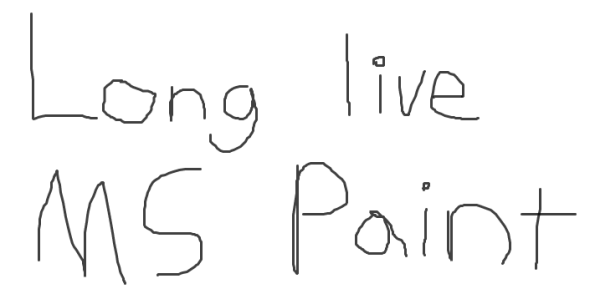On Monday morning, the internet was abuzz with sad news: Microsoft, we learned, is finally killing off Paint, the seminal drawing program that has been around since the first release of Windows in 1985. Getting into the mournful spirit, the Guardian asked its readers to submit their memories of the program. On Twitter, at least one user marked the program’s purported passing with a gravestone seemingly drawn—where else?—in Paint itself.
Look into the story a little more deeply, and you’ll realize that things aren’t quite so grim. In a post on changes coming to Windows 10 this Fall, Microsoft indicates that it won’t be stripping Paint from its flagship OS—at least not yet. Instead, Paint is one of many features scheduled to be “deprecated,” which means that it will no longer be “in active development and might be removed in future releases.” In other words, Paint isn’t quite dead yet; Microsoft is just sending it off to a retirement home and ignoring it while it lives out its final days.
Nevertheless, many have embraced the sorrowful spirit, offering celebratory remembrances and reminding us how great the program could be. Wired, for example, “tracked down some of the best art made within Microsoft Paint.” Wired notes the top posts on Reddit’s r/mspaint community will “put your terrible paint creations to shame.”
Many of those images demonstrate a striking willingness to laboriously grapple with, and push back against, the program’s limitations. The creator of a finely rendered version of the “astronaut sloth” meme writes that he or she “spent 45 hours on this guy, only using a mouse.” For such artists, Paint was a challenge to be overcome, a creatively generative form of restraint, not unlike the arbitrary restrictions that writers of the Oulipo school place on themselves.
It’s hard not to be impressed by their work, but dwelling on masterpieces misses what makes Paint worth mourning, even if it’s not actually passing into the digital twilight today. Microsoft Paint was always a clumsy program, but in its clumsiness, it offered a powerful demonstration of what computers could do. It was just sophisticated enough that there was always some new trick or tool to discover, but just simple enough that you could stumble through it on your own, sans tutorials or manuals. A virtual breach in the otherwise baffling circuitry of the machine, it offered a way in, acknowledging that computers were complicated, but told us not to fear them.
Try to recall your first time playing with it: Remember what it was like to hold the mouse’s left button down as you dragged your cursor across the screen. Maybe your hand shook slightly. Maybe you weren’t certain what you were trying to draw. One way or another, the line was jagged and rough, but it was still yours. Here there was evidence, however inexact the execution, that you could leave your own mark on the digital world.
Even if you never mastered the program, you likely found idiosyncratic ways to use it. An open, experimental canvas, it amplified your other interests instead of dictating your activities: I remember mapping out mazes for the Dungeons & Dragons games I would play with my friends—square rooms linked by rectangular corridors. Later, I tried to make my own Magic: The Gathering cards. No one would have confused my bootleg template with the real thing, but it still felt like I was contributing, not just playing a game that others had designed.
Those experiences are distant now, but I found myself thinking back on them recently as I experimented with Spaces, Facebook’s virtual reality meeting room product. Grabbing a blue pencil from the menu, I began to scribble, thick lines appearing in the air before me. As with my first experiences in Paint, my initial attempts were clumsy, the lines appearing and disappearing as I struggled to learn the controls. Trying to sign my name, I was left with something that looked like an imitation of Cy Twombly, and a bad one at that. And yet, as I had been when I first opened Paint decades before, I was still impressed with myself, newly convinced that I might one day master this strange interface.
Once, Paint served a similar function. Its awkardness was, to some extent, the point: The blank screen was a digital safe space, one in we could experiment on our own terms without risk. If Paint is fading now, it’s likely because we no longer need the assurances it offered us. Where it once helped us learn to think of the mouse as an extension of the hand, our fingers now slide over trackpads and touchscreens. We have long since internalized the things Paint taught us, allowing us to take up other tools.
Thus, while Microsoft may not actually be killing off Paint, it is, in a manner of speaking, dead already. But insofar as its lessons linger, Paint will never really die.
